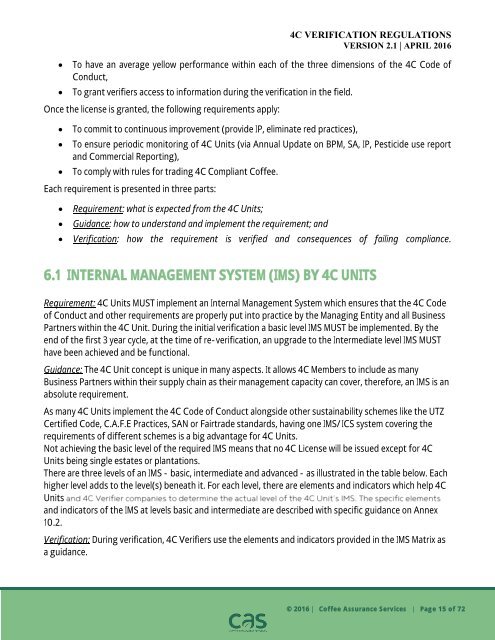VERIFICATION REGULATIONS
2byfvKv
2byfvKv
Create successful ePaper yourself
Turn your PDF publications into a flip-book with our unique Google optimized e-Paper software.
4C <strong>VERIFICATION</strong> <strong>REGULATIONS</strong><br />
VERSION 2.1 | APRIL 2016<br />
To have an average yellow performance within each of the three dimensions of the 4C Code of<br />
Conduct,<br />
To grant verifiers access to information during the verification in the field.<br />
Once the license is granted, the following requirements apply:<br />
To commit to continuous improvement (provide IP, eliminate red practices),<br />
To ensure periodic monitoring of 4C Units (via Annual Update on BPM, SA, IP, Pesticide use report<br />
and Commercial Reporting),<br />
To comply with rules for trading 4C Compliant Coffee.<br />
Each requirement is presented in three parts:<br />
<br />
<br />
<br />
Requirement: what is expected from the 4C Units;<br />
Guidance: how to understand and implement the requirement; and<br />
Verification: how the requirement is verified and consequences of failing compliance.<br />
6.1 INTERNAL MANAGEMENT SYSTEM (IMS) BY 4C UNITS<br />
Requirement: 4C Units MUST implement an Internal Management System which ensures that the 4C Code<br />
of Conduct and other requirements are properly put into practice by the Managing Entity and all Business<br />
Partners within the 4C Unit. During the initial verification a basic level IMS MUST be implemented. By the<br />
end of the first 3 year cycle, at the time of re-verification, an upgrade to the Intermediate level IMS MUST<br />
have been achieved and be functional.<br />
Guidance: The 4C Unit concept is unique in many aspects. It allows 4C Members to include as many<br />
Business Partners within their supply chain as their management capacity can cover, therefore, an IMS is an<br />
absolute requirement.<br />
As many 4C Units implement the 4C Code of Conduct alongside other sustainability schemes like the UTZ<br />
Certified Code, C.A.F.E Practices, SAN or Fairtrade standards, having one IMS/ICS system covering the<br />
requirements of different schemes is a big advantage for 4C Units.<br />
Not achieving the basic level of the required IMS means that no 4C License will be issued except for 4C<br />
Units being single estates or plantations.<br />
There are three levels of an IMS - basic, intermediate and advanced - as illustrated in the table below. Each<br />
higher level adds to the level(s) beneath it. For each level, there are elements and indicators which help 4C<br />
Units<br />
and indicators of the IMS at levels basic and intermediate are described with specific guidance on Annex<br />
10.2.<br />
Verification: During verification, 4C Verifiers use the elements and indicators provided in the IMS Matrix as<br />
a guidance.<br />
© 2016 | Coffee Assurance Services | Page 15 of 72


